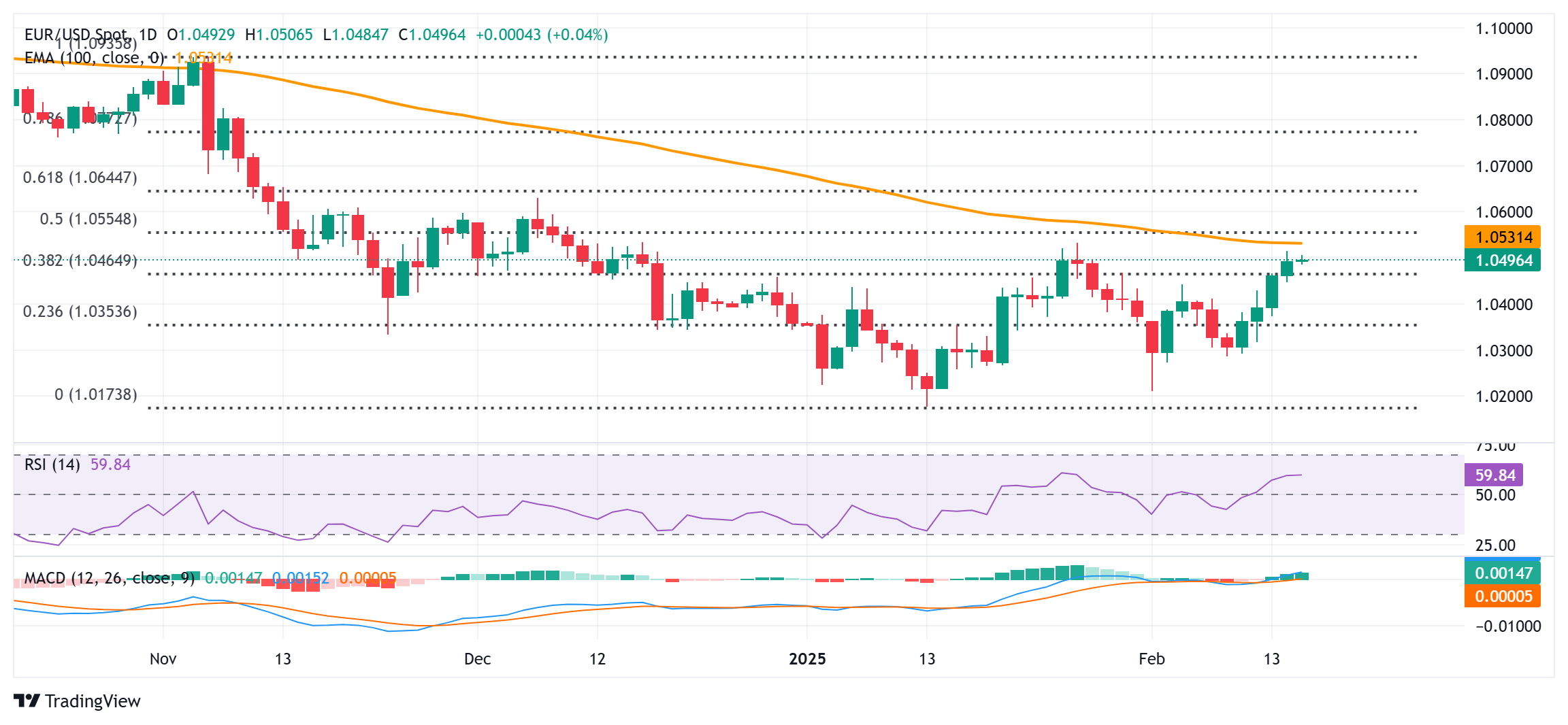EUR/USD Price Forecast: Stuck in a range near multi-week high, below 1.0500 mark
- EUR/USD consolidates last week’s strong gains to a nearly three-week high.
- The technical setup favors bulls and supports prospects for additional gains.
- Weakness below the 1.0465 support could pave the way for deeper losses.
The EUR/USD pair struggles to capitalize on its gains registered over the past four days and oscillates in a narrow trading band, just below the 1.0500 psychological mark during the Asian session on Monday. Spot prices, however, remain close to a nearly three-week high touched on Friday amid a weaker US Dollar (USD).
From a technical perspective, acceptance above the 38.2% Fibonacci retracement level of the November-January fall and positive oscillators on the daily chart favor bullish traders. Hence, a subsequent strength towards testing the 1.0545-1.0555 confluence, comprising the 50% retracement level and the 100-day Exponential Moving Average (EMA), looks like a distinct possibility.
Some follow-through buying should pave the way for additional gains and assist the EUR/USD pair to reclaim the 1.0600 mark. Spot prices might then climb to the December 2024 swing high, around the 1.0630 area, which nears the 61.8% Fibo. level. A sustained strength beyond will set the stage for an extension of the recent recovery from over a two-year low touched in January.
On the flip side, the 38.2% Fibo. level, around the 1.0465 region, now seems to protect the immediate downside. A convincing break below could drag the EUR/USD pair towards the 1.0400 round figure en route to mid-1.0300s (23.6% Fibo. level). Failure to defend the said support levels might shift the bias back in favor of bearish traders and expose the 1.0200 round-figure mark.
EUR/USD daily chart
Euro FAQs
The Euro is the currency for the 19 European Union countries that belong to the Eurozone. It is the second most heavily traded currency in the world behind the US Dollar. In 2022, it accounted for 31% of all foreign exchange transactions, with an average daily turnover of over $2.2 trillion a day. EUR/USD is the most heavily traded currency pair in the world, accounting for an estimated 30% off all transactions, followed by EUR/JPY (4%), EUR/GBP (3%) and EUR/AUD (2%).
The European Central Bank (ECB) in Frankfurt, Germany, is the reserve bank for the Eurozone. The ECB sets interest rates and manages monetary policy. The ECB’s primary mandate is to maintain price stability, which means either controlling inflation or stimulating growth. Its primary tool is the raising or lowering of interest rates. Relatively high interest rates – or the expectation of higher rates – will usually benefit the Euro and vice versa. The ECB Governing Council makes monetary policy decisions at meetings held eight times a year. Decisions are made by heads of the Eurozone national banks and six permanent members, including the President of the ECB, Christine Lagarde.
Eurozone inflation data, measured by the Harmonized Index of Consumer Prices (HICP), is an important econometric for the Euro. If inflation rises more than expected, especially if above the ECB’s 2% target, it obliges the ECB to raise interest rates to bring it back under control. Relatively high interest rates compared to its counterparts will usually benefit the Euro, as it makes the region more attractive as a place for global investors to park their money.
Data releases gauge the health of the economy and can impact on the Euro. Indicators such as GDP, Manufacturing and Services PMIs, employment, and consumer sentiment surveys can all influence the direction of the single currency. A strong economy is good for the Euro. Not only does it attract more foreign investment but it may encourage the ECB to put up interest rates, which will directly strengthen the Euro. Otherwise, if economic data is weak, the Euro is likely to fall. Economic data for the four largest economies in the euro area (Germany, France, Italy and Spain) are especially significant, as they account for 75% of the Eurozone’s economy.
Another significant data release for the Euro is the Trade Balance. This indicator measures the difference between what a country earns from its exports and what it spends on imports over a given period. If a country produces highly sought after exports then its currency will gain in value purely from the extra demand created from foreign buyers seeking to purchase these goods. Therefore, a positive net Trade Balance strengthens a currency and vice versa for a negative balance.




